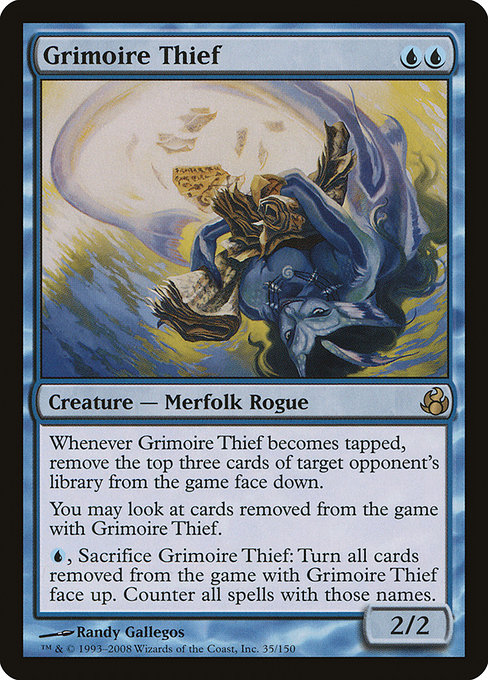
Image courtesy of Scryfall.com
Regional price disparities and collector behavior in MTG markets
In the vast, globe-spanning ecosystem of Magic: The Gathering, prices don’t rise in a vacuum. They travel with supply chains, language markets, and the quiet whispers of local tournaments and store shelves. When you pair a blue rare from Morningtide like Grimoire Thief with real-world commerce data, you get a cogent snapshot of how regional appetite shapes value. Blue staples—think control, disruption, and mind-games—tend to command premium in places where players lean into long games, commander circles, and e-strategy debates. 🧙🔥 The same card can feel like a steal in one city and a rarified treasure in another, simply because the local pool of copies, foil availability, and currency dynamics differ.
Grimoire Thief: blue staple with a twist
Grimoire Thief is a Merfolk Rogue from Morningtide released in 2008. With a modest mana cost of {U}{U} and a sturdy 2/2 body, its real strength isn’t raw power on the battlefield. It’s the hidden-information engine tucked into its lines: “Whenever this creature becomes tapped, exile the top three cards of target opponent's library face down. You may look at cards exiled with this creature. {U}, Sacrifice this creature: Turn all cards exiled with this creature face up. Counter all spells with those names.” Blue’s classic poke-and-probe toolkit gets a layered twist here, turning knowledge into a tempo swing and, with the sacrifice ability, a dynamic graveyard-to-counterplay playspace. This card embodies the artistry of blue design: you trade tempo for information, and information becomes leverage in the late game. 💎⚔️
“In MTG pricing, the true value is never just the number on a sticker; it’s the amount of possibility a card unlocks in a meta and in a collector’s imagination.”
From a gameplay perspective, the card rewards patient play and clever timing. Exiling cards face down blinds your opponent to what’s being accrued, while the optional look lets you stay informed without tipping your hand. The second line—turn all exiled cards face up and counter spells with those names—transforms the mechanic into a late-game coup de grâce against a spell-heavy plan. It’s a quintessential piece of blue ingenuity that also feeds into collector narratives: a rare from Morningtide that represents a specific era of MTG design and a tangible artifact of the blue-leaning strategies that defined the set. 🧙🔥
What drives regional price gaps?
- Supply distribution: Older sets like Morningtide have uneven print runs across regions, with geography shaping where foils and non-foils disappear first.
- Foil premium vs. non-foil baselines: Foil copies typically fetch a premium in many markets, reflecting demand for shiny, display-worthy versions in Commander and collection contexts. For Grimoire Thief, data shows about USD 0.73 for non-foil and USD 4.07 for foil, with EUR prices around a similar foil premium.
- Currency and import costs: Exchange rates and import duties tilt local price realities, making a card that’s affordable in one country comparatively pricey in another—even before factoring shipping and seller margins.
- Format-driven demand: EDH/Commander communities tend to keep blue staples in steady circulation, while Modern or Legacy play can create pockets of ephemeral demand depending on the local meta.
- Reprint risk and market psychology: The fear of a reprint or a sudden surge in popularity (perhaps due to a new commander list or a recent stream discussion) can nudge collectors to move earlier or hold longer, broadening price gaps.
Consider Grimoire Thief’s market snapshot as a microcosm: the card’s rarity and blue appeal keep it in the orbit of collectors who prize both function and nostalgia. The foil price is a telling indicator of how much the local scene values collector-grade presentations and the dramatic, glossy finish that brings the card to life in hand. In practice, savvy collectors watch price trails across currencies and regions, looking for signs of accumulation or fatigue. The lesson isn’t just about arbitrary numbers—it’s about reading the market’s heartbeat: the balance between supply, desire for foil-y elegance, and the ongoing appeal of blue’s strategic tempo. 🎲🧙♂️
Strategic takeaways for collectors and players
For players, Grimoire Thief isn’t just a curiosity; it’s a reminder that card design and timing can make a comparatively modest creature a pivot in a game plan. For collectors, regional price differences offer opportunities to time purchases for budget-conscious builds or completed-set ambitions. Keep an eye on foil availability in markets where collectors chase premium finishes; a surge in foil demand can pull non-foil prices along in its wake, even if the card’s play pattern remains niche. And if you’re chasing a pristine Morningtide artifact, consider cross-market trade windows that align with local tournament seasons—the quiet lull between major events can reveal favorable price shifts. 🧙🔥
Cross-promotional note: lifestyle gear for MTG fans
When you’re narrating a story about cards, it helps to pair the moment with a tangible keepsake. If you’re looking to elevate your everyday carry or show off your MTG pride, a slim, stylish phone case can be a perfect companion. Check out the Slim Phone Case for iPhone 16 Glossy Lexan Ultra-thin—clean, durable, and ready to ride along on your next round of cube drafting or local FNM. Slim Phone Case for iPhone 16 Glossy Lexan Ultra-thin
More from our network
- https://crypto-acolytes.xyz/blog/post/minecraft-rare-ores-explained-how-to-find-and-use-them/
- https://crypto-acoly.xyz/blog/post/how-governments-use-bitcoin-reserves-tactics-and-implications/
- https://transparent-paper.shop/blog/post/unlocking-advanced-seo-with-schema-markup-techniques/
- https://crypto-acoly.xyz/blog/post/building-a-minecraft-villager-trading-hall-your-complete-guide/
- https://crypto-acoly.xyz/blog/post/naked-eye-limits-meet-a-distant-hot-blue-star-in-ophiuchus/